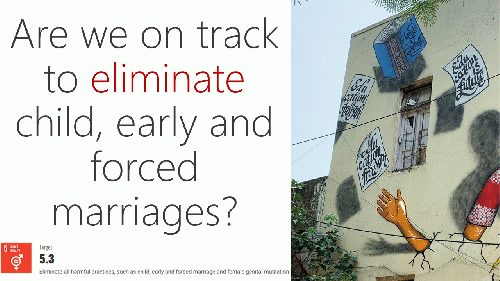
Child marriage is child rape: Ending child marriage is an imperative to deliver on promises of sustainable development
(Image by CNS) Details DMCA
According to a report by UNICEF, India is home to the largest number of child brides in the world, accounting for more than one third of the global total of 650 million women and girls who were married as children. Of the country's current total of 223 million child brides, 102 million were married before turning 15. Despite a legal ban on marriage of girls below 18 years of age, 27% of the girls in India are married before their 18th birthday and 7% are married before the age of 15. Girls living in rural areas are at greater risk. Structural inequalities, local culture and tradition, lack of education, poverty and insecurity, are some of the factors that are cited for this social evil that plagues our society.
Efforts, largely spearheaded by civil society organisations, have been able to reduce India's annual rate of child marriage to 5.5%, but a lot more remains to be done.
During tenth
virtual session of the 10th Asia Pacific Conference on Reproductive and Sexual
Health and Rights (APCRSHR), Dr Pramesh Chandra Bhatnagar, Senior Director
(Programme) at Voluntary Health Association of India (VHAI), shared how
peer-led approaches under the aegis of More
Than Brides Alliance are helping to change socio-cultural norms to reduce
child marriage and promote youth friendly sexual and reproductive health
services in 40 districts of India.
Dr Bhatnagar presented the details of one such comprehensive strategy being
implemented by VHAI that has succeeded in not only making 44 villages child
marriage free in Khalikote block of Ganjam district in Odisha, but has also
brought about meaningful socio-economic changes in the lives of adolescent
girls and boys through their active participation.
A baseline survey done in 177 villages of this block found that knowledge about
sexual and reproductive health in adolescents was very low at 7%. Only 10-11%
girls had any knowledge about menstruation, even among those who had started
menarche. Only 2-3% youth knew about any HIV/AIDS related information. And yet,
surprisingly there was a high prevalence of premarital sex, with more than 40%
of the girls being in such relationships. Thus brewed a lethal potion
comprising low knowledge of sexual and reproductive health and higher level of
sexual activity among adolescents. The baseline survey also helped to identify
barriers for adolescents' access to sexual and reproductive health services and
reasons for high prevalence of child marriages.
The next step was mapping the adolescent population in the project area. This
was followed by workshops to facilitate formation and capacity building of more
than 500 adolescent groups comprising over 11000 adolescent boys and girls.
Group members themselves chose their peer educators. These peer educators were
then trained in sexual and reproductive health and life-skills education.
Capacity building of the existing community groups and community leaders of the
villages was also done to engage diverse groups of actors in promoting
adolescent sexual health and prevention of child marriage.
Adolescent girls were motivated to develop their Charter of Demand, focussed
particularly on child marriage. The women's community groups developed a
community-based monitoring tool with indicators on sexual and reproductive
health and rights (SRHR) and child marriage. This proved to be a very
empowering tool that has helped the local community to monitor outreach
activities in the villages for not only addressing youth's sexual and
reproductive health issues but also looking into other developmental projects
taking place in the community.
The community groups have monthly meetings wherein the villagers come up with a
village health improvement plan, which the workers are supposed to fulfil and
report in the next meeting. If they have any problem the village women and
adolescent girls make the required intervention, especially by visiting the
local staff.
This comprehensive model has used a multi-pronged approach that goes beyond
preventing child marriages and improving sexual and reproductive health of
adolescents. It has also resulted in economic and social empowerment of the
girls, which includes giving them vocational training and supporting them to
start small initiatives. The two major fields which the girls of these villages
preferred, and where they excelled most, were computer training and mobile
phone repairing. Providing the girls with bicycles proved to be a game changer
as it empowered them to commute easily to school and training venues, even if
they were far away from their homes.
Adolescent leadership was enhanced through capacity building, promoting their
education and social skills, helping them in getting vocational training and
providing them with job opportunities. Alongside, engaging other stakeholders,
like village health workers, school teachers, local panchayat members and
district government officials has helped in influencing the socio-cultural
norms around child marriage and youth sexual and reproductive health.
These efforts have helped in averting 128 proposed child marriage cases, in
which the girls, peer educators and their groups played a major role, by
negotiating and advocating directly with the families involved. Also, as of
date, no child marriage has taken place in 44 villages since the past two
years.
The project has also helped in increasing institutional deliveries and birth
registrations to 95%, uptake of contraceptives, and community monitoring of
adolescent friendly sexual and reproductive health services.
70 information dissemination centres were formed for adolescents' vocational
and recreational activities as well as for dissemination of information on
sexual and reproductive health, including demonstration of use of contraceptive
products by government health staff. These centres are managed by the
adolescent peer educators themselves. 11 government health centres have been
converted into adolescent friendly health centres. They are open in the
afternoon only for the youngsters, who can visit them after school hours to
discuss sexual and reproductive health related issues with an auxiliary nurse,
midwife or a medical doctor.
(Note: You can view every article as one long page if you sign up as an Advocate Member, or higher).





